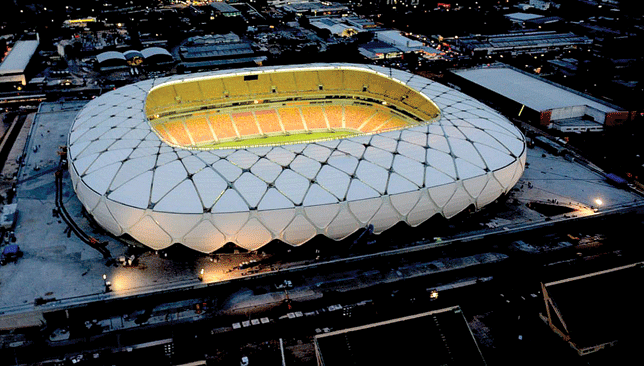
Last year, during the course of an interview, professor Andrew Scott of London Business School pointed out that the two stakeholders who will always make money in events like the Olympics and a World Cup are the governing bodies and athletes.
Scott insisted that in the whole equation of mega sporting events, the one partner that rarely makes any profit is the host venue.
It looks like a similar story is once again ready to be played out in Brazil this year. The Ministry of Tourism estimates that 3.7 million people will travel to the country during the World Cup, and will spend an average of $2,488 during their stay, resulting in an addition of $3.03 billion to Brazil’s economy.
Whether those numbers will be achieved or not remains to be seen, but the tournament is already the most successful World Cup ever – at least for FIFA, who have already got the money in the bank.
In a recent interaction with the media, FIFA secretary general Jerome Valcke said as much.
“The financial success – we have it, it is done. The ticket sales success is there, and we have never sold so many tickets,” he revealed.
With the tournament set to begin in less than three weeks’ time, almost three million tickets have been bought and most of the 64 matches are sold out.
Gate money hardly makes a tournament successful for FIFA. What it does is make it look beautiful. Half-empty stadiums is the worst thing to show on television pictures that will be viewed by close to a billion people every day.
Most of FIFA’s money comes through sponsorships and television deals. The Qatar-based beIN Sports and European networks have paid the majority of nearly $1.7 billion raised through sales of television rights.
The second biggest chunk is the sponsorship money. FIFA has six top-tier partners – adidas, Coca-Cola, Emirates, Hyundai, Sony, Visa – and eight second-tier sponsors – Budweiser, Castrol, Continental, Johnson & Johnson, McDonald’s, Moy Park, Oi and Yingli.
According to financial reports, the combined fee paid by these 14 companies to associate with the biggest global sporting event is $1.32 billion.
The pool of ‘national sponsors’ – mostly Brazilian companies – will fetch close to $120 million. The rest is made up of corporate hospitality, ticket and merchandise sales.
As of now, while FIFA’s balance sheet will be healthier by nearly $4 billion (revenue earned from South Africa in 2010 was $3.2 billion, so it is a jump of approximately 25 per cent), Brazil will be left staring at a whopping bill of $14 billion.

This includes the renovation of 12 stadiums, upgrading of infrastructure like airports and roads in all host cities, and providing security before and during the tournament.
To be fair, much of the infrastructure is also being made to meet the demands of the IOC and the 2016 Olympics.
Of course, it is impossible to calculate the intangibles for the host countries – like the happiness and pride it brings to the sports fans, the legacy and infrastructure it leaves which helps then produce future world champions, the value of the media exposure across the globe and the tourism potential it unlocks.
But the local governments do not get anything by way of taxes because organisers like FIFA and the IOC ensure tax-free status for their events, and any marketing activities being done to promote them, at the negotiation stage itself – and the outflow for them is in hard cash.
The World Cup does generate a lot of jobs, but a majority of them are temporary. In South Africa, the 2010 World Cup created 22,000 jobs, but more than 80 per cent of them had to look for another job once the tournament was over.
On top of that, labour exploitation remains an issue. In South Africa, Building and Wood Workers International (BWI) research showed construction workers were paid as little as $1 per hour at World Cup sites.
Local businesses always have an issue with events like the World Cup and Olympics, as they almost take over big areas around the venues in an effort to prevent ambush marketing and bring more value for their own sponsors.
There is no denying that much of the money made by FIFA is spent on developing football around the world, but there is also a growing feeling that they should ensure that local governments are not spending truckloads on the event.
The World Cup is FIFA’s showpiece event, and the money generated helps them conduct such important tournaments like the Women’s and other age-category World Cups.
It also funds the $250,000 annual grants to each of its 209 member federations and $2.5 million for the six continental bodies. In 2013, FIFA spent $27 million on developing pitches and training centers.
So, what’s the way out, so that FIFA can continue to make their profit, and yet, the World Cup does not cause the kind of hardship and negative sentiments it has in South Africa, and now in Brazil?
Most experts feel that only developed countries, which already have the necessary infrastructure like airports, hotels and stadiums, or rich nations like Qatar or Brunei, which will not feel the pinch of the massive costs, should be allowed to host the World Cup.
It may go against FIFA’s objectives of spreading the game, but at least the taxpayers’ money in developing countries can be used to cater to the more basic demands and not result in the kind of scenes that we are witnessing from Brazil on a daily basis.